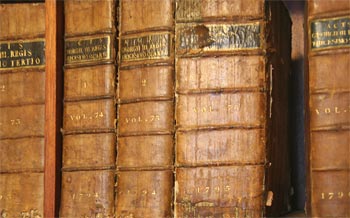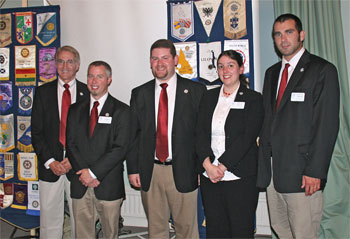
An Exchange of the Archivists
In fall 2009, I had the opportunity to represent Colby-Sawyer College as part of a five-person team of young professionals from New Hampshire and Vermont selected by Rotary International to participate in the Group Study Exchange (GSE) program. We traveled across the pond to explore the counties of Kent and East Sussex in southeast England and to visit vocational sites there. Our goal was to experience England's culture and institutions, observe how our respective vocations are practiced abroad, develop both personal and professional relationships, and to exchange ideas with our British counterparts.
I traveled with team leader and Rotarian Steve Christensen, an orthodontist from Concord, N.H.; Scott Cunan, a telecommunications technician from Candia, N.H.; Paul Smith, a legislative aide from Farmington, N.H.; and Justin Tanger, a skylight installer from Mount Holly, Vt. Each team member stayed with eight host Rotarian families during the trip, giving us the unique opportunity to experience life in a variety of English households.
Our four-week journey took us across the counties of Kent and East Sussex in the southeast corner of England. Kent is known as the Garden of England due to the abundance of orchards and hop-gardens found there. It was heavily involved in the Battle of Britain during World War II and is well known for its Cinque Ports (Hastings, Sandwich, Dover, New Romney and Hythe), often pronounced “sink” ports. East Sussex, one of England's most green and lush counties, is known for its role in the Battle of Hastings in 1066 and also contains the famed landmark of Beachy Head.
Custard or Cream?
We often think that there is little difference between Americans and our British counterparts when in reality there are many subtle differences, and some created confusion and entertainment throughout the trip. We often joked with our hosts that we are two countries separated by a common language.
A few of the team members, myself included, are self-proclaimed Anglophiles who spend large amounts of our free time watching BBC America. Other members, though, were less familiar with all things British and terms such as loo, pudding, the first floor and shorts (which Americans call the bathroom, dessert, the second floor and underwear, respectively). Fortunately, one of our host families purchased an English-to-American English dictionary to help clear things up.
In addition to language quirks, we discovered a few other things: The English really do drink that much tea. A popular pudding topping is a choice of custard or cream. What you might not expect (and I didn't) is that this topping will be liquid and warm. Anything built in the 18th century or later is considered new.

Canterbury Cathedral Archives
As an archivist, I had the opportunity to visit with professionals at nine archives, museums and libraries. I saw and learned too much to share it all here but will provide highlights from my two favorite visits: Canterbury Cathedral and Windsor Castle.
Founded by St. Augustine in 602, Canterbury Cathedral is one of the oldest Christian churches in England. It is probably best known as a major pilgrimage destination after the martyrdom of St. Thomas Becket in 1170 and as the subject of Geoffrey Chaucer's Canterbury Tales. The destruction of Becket's shrine came more than 350 years later in 1538, on the orders of King Henry VIII. While visiting, I was able to see several documents they were preparing for a Henry VIII exhibition celebrating the 500-year anniversary of his coronation, such as prayer books with Becket's name carefully torn out and marble pieces believed to be the only remaining pieces of Becket's shrine.
The day before my visit we had toured the cathedral as a team, but I never guessed that one of the doors we passed led to a treasure trove of manuscripts and artifacts. The archives is located inside the cathedral on the site of the medieval dormitory and has existed at the cathedral for at least 1,300 years. Although the library and archives are separate entities, the public search room is run jointly between the Canterbury Cathedral Archives and the Canterbury Cathedral Library. I met with a librarian and an archivist who informed me that I was on quite the busman's holiday.
The archives contains five major collections: the Dean & Chapter of Canterbury, the City of Canterbury, the Diocese of Canterbury, the Church of England Parishes within the Archdeaconry of Canterbury, and unofficial collections. The types of materials found in these collections relate to churches, local government, business and trade, schools and education, charities and hospitals, and families and estates. The library and archives are spread out over several floors and a dumb-waiter style lift is used to move materials from storage to the reading room. The archives has 11 staff members (not including volunteers) and four store rooms, only one of which is on site. They are fortunate in having a full-time conservator on site and a staff member devoted solely to the task of digitizing documents.
Windsor Castle
My favorite visit was to the Chapel Archives and Chapter Library at the College of St. George, Windsor Castle. Something about getting a police escort into the castle made the experience verge on surreal. Unfortunately, the queen wasn't in residence, yet there was still plenty to see and learn.
The archives hold the records of the Order of the Garter, the oldest surviving Order of Chivalry in the world. The order was founded by Edward III and membership is limited to the monarch, the Prince of Wales and no more than 24 members—all selected by the monarch. The order also includes additional members such as the British Royal Family and foreign dignitaries who do not count toward the 24-companion limit. The Chapel Archives contains deeds, letters, rolls and other manuscripts dating from the early 12th century. These materials trace the history of the chapel as well as that of the properties it used to hold in England and Wales.
I met with Clare Rider, the archivist and chapter librarian; Eleanor Cracknell, the assistant archivist; and Kelda Roe, a work experience student. Clare gave me an overview of the archives and the College of St. George and discussed the kinds of lectures and group visits that are part of their outreach programs and their plans for primary and secondary schools, which include a scavenger hunt in the chapel. She also showed me the featured picture of the month on the web site's home page and a blog that the trained archivists or work experience students typically update twice a month.
Next, Eleanor showed me their catalog, which is essentially what we would call “finding aids.” Their finding aids are more research guides that focus on the historical context of the collection. She also showed me their recent digitization projects, currently stored on an intranet. I was interested to learn that the U.K. has no equivalent to this nation's fair use policy, which allows limited use of copyrighted materials for educational, research or reporting purposes. Even producing an in-house copy of a document in their possession, but for which they do not hold copyright, is viewed as a copyright violation.

Finally, Kelda Roe took me on a tour of the exhibition space where I saw their oldest document, a land deed which dates from the 1100s, and the store rooms. We finished up the day with a tour of the chapel itself, which the rest of my team (they had been touring Windsor Castle) joined me for.
The highlight of the tour was seeing the Order of the Garter stalls located in the chapel choir. Each stall contains the member's sword, a heraldic banner and a stall plate which displays the member's name, arms, and date of instillation. Upon the death of a member, all of these items are removed with the exception of the stall plate, which remains permanently affixed somewhere in the stall.
All of my vocational visits gave me an interesting perspective on British archives. Overall, we are not as different as we used to be; both schools of practice have begun to move towards similar methods of appraisal and processing. There were, however, some interesting differences. Most smaller archives were closed to the public or available by appointment only and many archives charged for research services and digitization.
The larger archives tended to be more open and were pushing the digitization of their materials to improve user access. The software systems the British have in place are years ahead of our own. The biggest difference I noticed was in archivists' education. In the United States, archivists earn a Master's in Library Science with a concentration in Archives Management and internships associated with this specialty are done concurrently.
In the U.K., someone interested in archives spends one year working in the profession to show a commitment to the profession before applying to archival programs. It is up to the student to find the job, although resources exist to help in the search. The programs focus solely on archives and last for about a year. During the coursework, the students do an additional two-week training session on cataloging. Some subjects they study are very different than what we study in the states, including palaeography, the study of handwriting, and Latin, the language of many early texts. These differences exist because their documents tend to be older. One archivist said she thinks that it is actually easier for them because modern handwriting is not standardized like early handwriting.
This trip was truly a once-in-a-lifetime experience. I have walked away with a better understanding of British culture, ideas to improve the Cleveland Colby Colgate Archives, and with many new personal and professional friends whom I hope to remain in contact with for many years to come.



